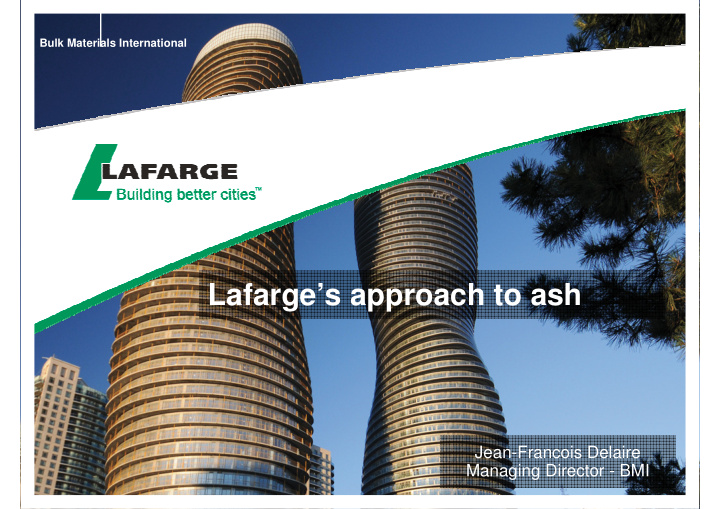



Bulk Materials International Lafarge’s approach to ash Jean-Francois Delaire Managing Director - BMI
Contents � Some background on Lafarge � Lafarge’s use of ash and other cementitious materials � The role of BMI within the Lafarge network � The seaborne ash trading market � Future challenges 2
��������������������������������������� Leading positions in key construction sectors � N°1 worldwide in Cement N°2 worldwide in Aggregates N°4 worldwide in Concrete €15.8 billion of sales � Operations in 64 countries � 65,000 employees � A commitment to “green” initiatives, including increased usage of � cementitious materials WWF Conservation Partner, including initiatives on: ■ Sustainable construction ■ Climate change ■ Water conservation ■ Biodiversity
������������������������������������������ By product MT Slag 10 Fly ash 12 Pozzolan 4 Limestone 12 Total 38 By usage MT Raw mix 2 Blended cements 30 Direct sales 6 Total 38 NB : Fly ash competes with other materials
������������������������������������������������������ • France : 0,5 MT • Deposits / Drying • USA : 2 MT • Disposal sites Ash benefication • Blending terminals • Carbon removal + reburn • UK : 0,5 MT • Lafarge UK • Ash beneficiation • Lafarge Poland • Ammonia removal • Poland : 1 MT • Lafarge UK • Deposits / Drying • Ash classification • Use in raw mix • Lafarge UK • Ash beneficiation • Lafarge South- Africa • South Africa : 1,5 MT • Classification • China : 2 MT • FGD gypsum off-take • India : 1 MT 5
����������������������������������������������������� ������������������������������������������� Limestone in (by sea, rail or FBA to road) aggregates end use Construction materials in during FBA to building clinker (aggregates & production concrete) Total Ash management Ash for Ash for Gypsum cement clinker for cement For non production production production cementitious applications Expertise and involvement in design of process plant including handling, storage and ash beneficiation technology
�������������� ��������������� BMI is the Lafarge trading entity for cementitious materials � • Seaborne trading only • Supplying both Lafarge and non-Lafarge customers – Third-party sales account for around 30% of volumes and this is expected to grow in the future BMI also provides technical, commercial and strategic support to � Lafarge operating businesses • Advising on best sourcing options, contract-making, quality control • Providing benchmarks thanks to global coverage BMI develops long term partnerships with both suppliers and � customers • Logistics and marketing support • Infrastructure design Support from Lafarge • Product analysis Network and partners • Beneficiation technologies
�� ����������!���������������������������
�������������"�������������������������������������� ����������������������������������������
��������������������������������#�������$���%���� Main flows : From East India � • To Bangladesh (bulk) From West India � • To the Middle-East (big bags) From Japan � • To Korea (bulk) From Italy � • To Europe (bulk) Modest compared to slag (17 MT) and cement (120 MT)
Key challenges for developing seaborne ash trading � Logistics constraints � Silo capacity at loading/unloading points � Berthing and unloading capabilities � Categorisation as a “waste” � Restrictions to trading � Bureaucratic authorisation process � Ash Quality � Carbon levels � Ammonia levels � Increased use of biomass � Mercury treatment � Ash Availability � Increased market share of gas/renewables � Seasonality of production Lafarge Poland 11
Summary � Ash plays a key role in Lafarge’s product strategy, although it is competing with other cementitious materials. � There is room for an even stronger role, however : � The “easiest” sources, in terms of quality and logistics, are already consumed. � Untapped opportunities exist, but require processing and development of logistic infrastructure… meaning capex � Seaborne trading of ash has become an essential element of Lafarge’s strategy regarding ash � BMI is in charge of implementing this strategy � The role requires managing ash quality, waste regulations, reliability of service, and optimum logistics � Lafarge believes in long term partnerships with power utilities ensuring mutual understanding, investment in infrastructure and processing technologies. � Successful partnerships require a fair sharing of the value chain (win-win philosophy) 12
Recommend
More recommend